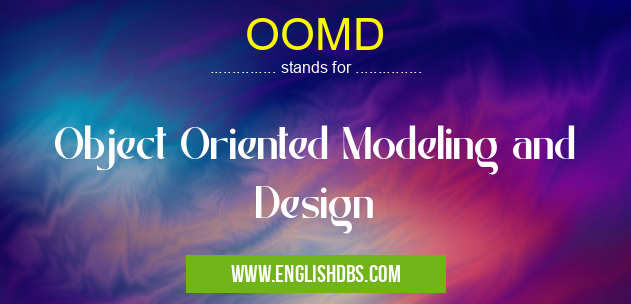What does OOMD mean in SOFTWARE
Object Oriented Modeling and Design (OOMD) is a software development process that uses object-oriented programming principles to create software models or designs. It combines aspects of object-oriented programming, domain modeling, and analysis to form a unified whole. OOMD helps developers to understand the problem and its context in order to create efficient solutions. By using this method, companies can better identify and organize problems in order to develop efficient solutions quickly.

OOMD meaning in Software in Computing
OOMD mostly used in an acronym Software in Category Computing that means Object Oriented Modeling and Design
Shorthand: OOMD,
Full Form: Object Oriented Modeling and Design
For more information of "Object Oriented Modeling and Design", see the section below.
Object-Oriented Programming
Object-oriented programming (OOP) involves creating objects, classes, and methods that interact with one another. An object is an entity that contains data and methods to modify or manipulate the data. A class is a template that defines how a particular object should look like and behave. The methods are functions associated with a class that allow it to process data or manipulate objects in some way. Object-oriented programming allows for more organized development of software applications.
Domain Modelling
Domain modelling is the process of studying real-world phenomena in order to gain insight into how they work. This knowledge can then be applied to develop solutions for those problems. Domain modelling involves breaking down complex problems into simpler parts, identifying relationships among them, creating models of these parts and their relationships, experimenting with different design solutions, and finally documenting the results so others may learn from them as well.
Analysis
Analysis plays an important role in OOMD by understanding business requirements accurately through use cases or functional specifications documentations which are written by end user stakeholders who have specific goals for what the final system should do. With this information, developers can make decisions on how best to structure their application code before diving deep into implementation details. Analysis also encompasses design review cycles where core business requirements are analyzed against the proposed implementation strategy in order to ensure correctness as well as identify any potential pitfalls early on in the development phase.
Essential Questions and Answers on Object Oriented Modeling and Design in "COMPUTING»SOFTWARE"
What is Object-Oriented Modeling and Design?
Object-oriented modeling and design (OOMD) is a software engineering process used to develop quality, maintainable applications. It involves the use of object-oriented programming languages like Java, C# or C++ in combination with a visual modeling approach like UML. OOMD focuses on defining reusable components that can be configured and reused throughout an application.
How does Object-Oriented Modeling and Design help development teams?
OOMD helps development teams by providing them with a structured process for developing applications. This process helps identify the objects that will make up the application, as well as their relationships to each other. OOMD also provides reusable components that can save time during development.
What are the benefits of using Object-Oriented Modeling and Design?
The benefits of using OOMD include better code organization, improved readability, increased scalability, easier debugging, faster development speed, lower costs for maintenance and more potential for collaboration among developers. Additionally, many modern frameworks leverage OOMD principals to provide an efficient way to create web applications.
What are some typical activities involved in Object-Oriented Modeling and Design?
Typical activities associated with OOMD include creating class diagrams to define objects, setting up relationships between classes, implementing inheritance hierarchies and mapping out how these objects interact with one another within an application's design architecture. In addition, developers may opt to use additional tools such as UML (unified modeling language) or IDEs (integrated development environments) when designing an application's structure.
Is Object-Oriented Modeling and Design hard to learn?
Depending on your background knowledge of programming languages, learning OOMD can range from being quite simple to more difficult depending on how deep you want to go into it. It’s important to have familiarity with object-oriented principles such as encapsulation, abstraction and inheritance before getting started with any visual models such as UML or ER diagrams
Final Words:
Object Oriented Modeling and Design (OOMD) is an effective software development technique that combines aspects from object-oriented programming, domain modelling, and analysis to form an integrated whole. OOMD helps developers think more critically about how best to structure their application code while providing them with insights into potential risks that could arise during implementation phases. Through using this method companies are able to produce efficient designs quickly ensure accuracy between customer requirements and final products delivered.
